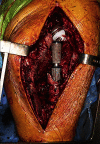Pseudoaneurysm following Two-Stage Hip Revision with Fasciotomy
- PMID: 36601446
- PMCID: PMC9807314
- DOI: 10.1155/2022/6254542
Pseudoaneurysm following Two-Stage Hip Revision with Fasciotomy
Abstract
In the setting of total hip arthroplasty (THA), pseudoaneurysms are extremely rare and can be difficult to diagnose, as clinical symptoms can mimic symptoms of other more common complications, such as periprosthetic joint infection, hematoma, and nerve damage. We present a case of a 69-year-old male with a history of slipped capital femoral epiphysis 56 years prior and subsequent right THA. The right hip primary arthroplasty was subsequently complicated by multiple dislocations and recurrent prosthetic joint infections. The most recent infection was treated with debridement, antibiotics, and implant retention (DAIR) in 2017. The patient later presented in 2019 with right thigh pain. Upon further analysis, he was diagnosed with Streptococcus bovis positive periprosthetic joint infection. The patient underwent a two-stage revision of the hip using an antibiotic spacer. Two weeks following the second stage, he presented with a sudden onset of uncontrolled atrial fibrillation with rapid ventricular response and a low hemoglobin. The computed tomography scan revealed a large hematoma involving both the anterior and posterior thigh compartments with lab markers that were questionable for infection. An operation to remove the hematoma revealed no purulence, and a large pulsatile pseudoaneurysm on the posterolateral aspect at the mid femur was found. A sharp bone fragment was noted next to the pseudoaneurysm. The pseudoaneurysm was repaired by a vascular surgeon, and the bone fragment was removed. Following this procedure, the patient developed a subsequent periprosthetic joint infection requiring a double DAIR procedure six weeks following the pseudoaneurysm repair and is now on chronic antibiotic suppression. Orthopedic surgeons should be aware of the potential for pseudoaneurysm in the setting of total joint arthroplasty when treating a postsurgical hematoma of sudden onset.
Copyright © 2022 Jordan R. Pollock et al.
Conflict of interest statement
The author(s) declare(s) that they have no conflicts of interest.
Figures








References
-
- Healy W. L., Iorio R., Clair A. J., Pellegrini V. D., Della Valle C. J., Berend K. R. Complications of total hip arthroplasty: standardized list, definitions, and stratification developed by The Hip Society. Clinical Orthopaedics . 2016;474(2):357–364. doi: 10.1007/s11999-015-4341-7. - DOI - PMC - PubMed
-
- Erschbamer M., Den Hollander J., Sauter D., Erhardt J., Hechelhammer L., Külling F. Endovascular embolisation is a successful and safe treatment for post-operative arterial complications after total hip arthroplasty and revision surgery. International Orthopaedics . 2016;40(8):1577–1582. doi: 10.1007/s00264-015-3058-2. - DOI - PubMed
Publication types
LinkOut - more resources
Full Text Sources
Miscellaneous

